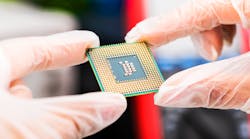Semiconductor Industry Stands to Lose in Trade War, Analyst Says
No country builds more of the world’s chips than the United States, and no country imports more chips than China. And the trade war brewing between them could end up hobbling the electronics industries of both countries, wrote Myson Robles Bruce, an analyst for market research firm IHS Markit.
The dispute could temper booming sales of memory, processors and other chips increasingly critical for the automotive and industrial sectors. And many companies could end up paying tariffs of their own chips during assembly and testing. That would drive higher costs for electronics manufacturers, hampering sales of consumer electronics and other gadgets and tamping down demand for chips.
“For the semiconductor space, the escalating tariff dispute between the United States and China will be a bruising zero-sum game injurious to both sides," Robles-Bruce wrote in a recent blog post. However, some other industry analysts point out that the trade war could end up boosting the self-sufficiency of China's homegrown chip industry, loosening its dependence on American chips.
The trade conflict shifted into high gear last month when the Trump administration enacted 25-percent tariffs on $34 billion of Chinese goods, including components like capacitors and diodes. The tolls were met with Chinese tariffs on American agricultural goods like soybeans and nuts. The conflict could worsen as President Trump mulls tariffs on another $16 billion worth of products, including certain processors and memory chips.
What began as the administration’s attempt to curtail the $375 billion trade imbalance with China – and checking its ambitions in sectors like robotics and aerospace – could end up cooling the recent semiconductor boom. While the fallout from the tariffs remains to be seen, industry analysts say they could cut into the market for chips and the equipment used to fabricate them.
Robles-Bruce points out that many chips designed in the United States are manufactured in China. Others are fabricated in the United States and outsourced to China for tasks like assembly, packaging and testing. Many stay there to be used by Chinese electronics manufacturers, while others return to the United States to be used in automobiles, planes or industrial equipment.
The recent conflict over electronics manufacturer ZTE underscores the bond between the Chinese and American technology sectors. The company was on the brink of shutting down after the United States imposed constraints on its ability to import chips from American suppliers. But the Trump administration swooped in to replace the ban with more than a billion dollars of fines, allowing ZTE to remain in business. On Monday, the ban was finally lifted.
The chip industry is wringing its hands over the tariffs, which were imposed in response to technology transfers and other Chinese tactics to pilfer American businesses operating in the country. The Semiconductor Industry Association has long condemned these tactics but warned that tariffs are not the answer. It says the tariffs are counterproductive and harmful to American competitiveness in chips, cutting into American research and development.
Last year, the value of chips used by Chinese manufacturers amounted to $192.5 billion. And yet, while companies based in the United States designed $214.8 billion of the world's chips last year, Chinese rivals only accounted for $14.4 billion. Around $57.2 billion worth of chips used in American manufacturing could be tolled as part of the administration's tariffs, said Robles-Bruce.
“While it is true that the United States has tremendous leverage over China in chip design, China has immense power in the semiconductor supply chain. In this sense, both countries are needed to drive the industry,” Robles-Bruce, previously an analyst for National Semiconductor and Apple, wrote. “Businesses must then absorb somehow the increased costs resulting from the tariffs, or pass them on to consumers."
He added, "there are no winners."








